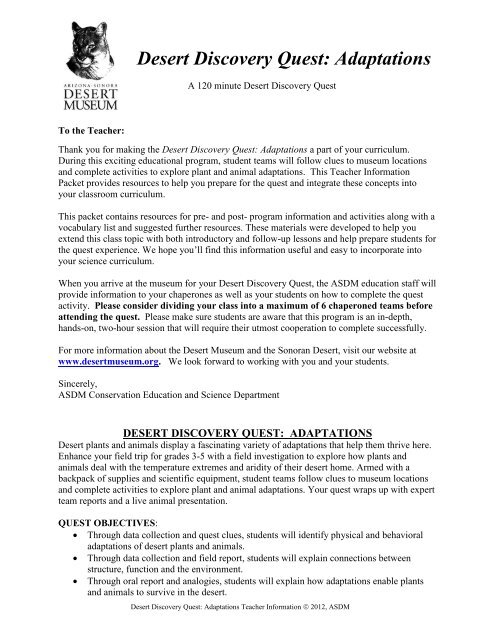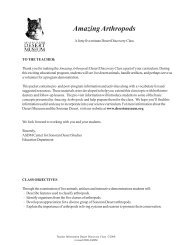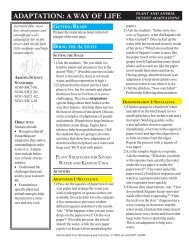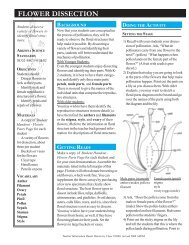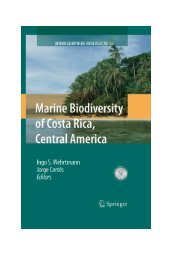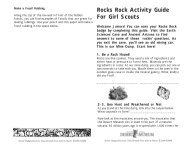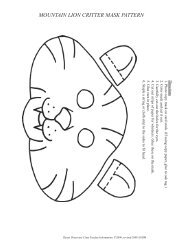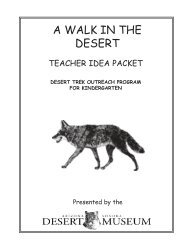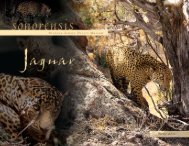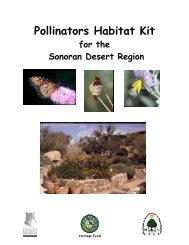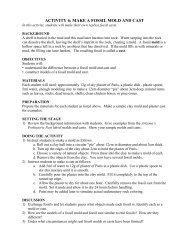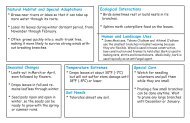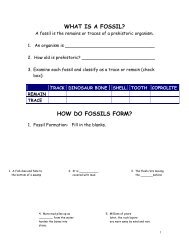Desert Discovery Quest: Adaptations - Arizona-Sonora Desert ...
Desert Discovery Quest: Adaptations - Arizona-Sonora Desert ...
Desert Discovery Quest: Adaptations - Arizona-Sonora Desert ...
Create successful ePaper yourself
Turn your PDF publications into a flip-book with our unique Google optimized e-Paper software.
<strong>Desert</strong> <strong>Discovery</strong> <strong>Quest</strong>: <strong>Adaptations</strong><br />
A 120 minute <strong>Desert</strong> <strong>Discovery</strong> <strong>Quest</strong><br />
To the Teacher:<br />
Thank you for making the <strong>Desert</strong> <strong>Discovery</strong> <strong>Quest</strong>: <strong>Adaptations</strong> a part of your curriculum.<br />
During this exciting educational program, student teams will follow clues to museum locations<br />
and complete activities to explore plant and animal adaptations. This Teacher Information<br />
Packet provides resources to help you prepare for the quest and integrate these concepts into<br />
your classroom curriculum.<br />
This packet contains resources for pre- and post- program information and activities along with a<br />
vocabulary list and suggested further resources. These materials were developed to help you<br />
extend this class topic with both introductory and follow-up lessons and help prepare students for<br />
the quest experience. We hope you’ll find this information useful and easy to incorporate into<br />
your science curriculum.<br />
When you arrive at the museum for your <strong>Desert</strong> <strong>Discovery</strong> <strong>Quest</strong>, the ASDM education staff will<br />
provide information to your chaperones as well as your students on how to complete the quest<br />
activity. Please consider dividing your class into a maximum of 6 chaperoned teams before<br />
attending the quest. Please make sure students are aware that this program is an in-depth,<br />
hands-on, two-hour session that will require their utmost cooperation to complete successfully.<br />
For more information about the <strong>Desert</strong> Museum and the <strong>Sonora</strong>n <strong>Desert</strong>, visit our website at<br />
www.desertmuseum.org. We look forward to working with you and your students.<br />
Sincerely,<br />
ASDM Conservation Education and Science Department<br />
DESERT DISCOVERY QUEST: ADAPTATIONS<br />
<strong>Desert</strong> plants and animals display a fascinating variety of adaptations that help them thrive here.<br />
Enhance your field trip for grades 3-5 with a field investigation to explore how plants and<br />
animals deal with the temperature extremes and aridity of their desert home. Armed with a<br />
backpack of supplies and scientific equipment, student teams follow clues to museum locations<br />
and complete activities to explore plant and animal adaptations. Your quest wraps up with expert<br />
team reports and a live animal presentation.<br />
QUEST OBJECTIVES:<br />
Through data collection and quest clues, students will identify physical and behavioral<br />
adaptations of desert plants and animals.<br />
Through data collection and field report, students will explain connections between<br />
structure, function and the environment.<br />
Through oral report and analogies, students will explain how adaptations enable plants<br />
and animals to survive in the desert.<br />
<strong>Desert</strong> <strong>Discovery</strong> <strong>Quest</strong>: <strong>Adaptations</strong> Teacher Information 2012, ASDM
ARIZONA ACADEMIC STANDARDS IN SCIENCE CORRELATION<br />
The <strong>Desert</strong> <strong>Discovery</strong> <strong>Quest</strong>: <strong>Adaptations</strong> and supplemental activities correlate to these <strong>Arizona</strong><br />
Academic Science Standards. See each activity for specific standards and performance<br />
objectives.<br />
Life Science<br />
SC03-S4C1-01<br />
SC04-S4C1-01&02<br />
SC03-S4C3-01,03&05<br />
SC04-S4C3-01&03<br />
SC03-S4C4-01&02<br />
SC04-S4C4-01&02<br />
Inquiry Process<br />
SC03-S1C1-01<br />
SC04-S1C1-03<br />
SC05-S1C1-02<br />
SC03-S1C2-01,03,04&05<br />
SC04-S1C2-01,03,04&05<br />
SC05-S1C2-01,04&05<br />
SC03-S1C3-01&02<br />
SC04-S1C3-05<br />
SC05-S1C3-05<br />
SC03-S1C4-01&03<br />
SC04-S1C4-01&03<br />
SC05-S1C4--01&03<br />
Social Studies<br />
SS03-S4C1-02<br />
SS04-S4C1-01&02<br />
<strong>Arizona</strong> State Science Standards<br />
Strand 1: Inquiry Process<br />
Concept 1: Observations, <strong>Quest</strong>ions, and Hypotheses<br />
Concept 2: Scientific Testing (Investigating and Modeling)<br />
Concept 3: Analysis and Conclusions<br />
Concept 4: Communication<br />
Strand 4: Life Science<br />
Concept 1: Characteristics of Organisms<br />
Concept 3: Organisms and Environments<br />
Concept 4: Diversity, Adaptation and Behavior<br />
<strong>Arizona</strong> State Social Studies Standards<br />
Strand 4: Geography<br />
Concept 1: The World in Spatial Terms<br />
RESOURCES<br />
Literature:<br />
<strong>Arizona</strong>-<strong>Sonora</strong> <strong>Desert</strong> Museum. A Natural History of the <strong>Sonora</strong>n <strong>Desert</strong>. Tucson:<br />
ASDM Press, 1999.<br />
Gibbons, Gail. <strong>Desert</strong>s. New York: Holiday House, 1996.<br />
Kalman,, Bobbie. How do animals adapt The science of living things. NewYork:<br />
Crabtree Publishing, 2000<br />
Mc Carthy, C. Eyewitness Books: <strong>Desert</strong>. New York: Alfred A. Knopf, 1991. (Many<br />
other books in the Eyewitness series contain information on desert species.)<br />
Murphy, Julie. <strong>Desert</strong> animal adaptations. Capstone Press, 2011<br />
Silver, Donald M. One Small Square: Cactus <strong>Desert</strong>: New York:Learning Triangle Press<br />
1995<br />
Slade, Suzanne. What do you know about animal adaptations Powerkids Press, 2008<br />
Townsend, John. Would you survive Animal and plant adaptations. New York Raintree<br />
Fusion, 2005<br />
Wallace, Marianne D. America’s <strong>Desert</strong>s: Guide to Plants and Animals. Colorado:<br />
Fulcrum Publishing 1996<br />
<strong>Desert</strong> <strong>Discovery</strong> <strong>Quest</strong>: <strong>Adaptations</strong> Teacher Information 2012, ASDM
Websites/Organizations<br />
<strong>Arizona</strong>-<strong>Sonora</strong> <strong>Desert</strong> Museum: 2021 N. Kinney Rd., Tucson, AZ 85743. Phone:<br />
(520)883-3025. www.desertmuseum.org<br />
ASDM Fact pages: http://desertmuseum.org/kids/oz/long-fact-sheets/<br />
ASDM Digital Library: http://www.desertmuseumdigitallibrary.org/public/index.php<br />
ARKive: http://www.arkive.org/<br />
<strong>Desert</strong>USA: http://www.desertusa.com/<br />
_________________________________________________________________<br />
VOCABULARY<br />
Adaptation: A body part or behavior of an animal or plant that helps it survive in its<br />
environment (i.e. an eagle has sharp talons that help it grab and hold its prey)<br />
Behavior: The response of an individual, group, or species to its environment<br />
Burrow: A hole or excavation in the ground made by an animal (as a rabbit) for shelter and<br />
habitation<br />
Camouflage: Concealment by means of disguise or a behavior designed to deceive or hide<br />
Crepuscular: Usually active at dawn or dusk<br />
Deciduous: Falling off or shed seasonally or at a certain stage of development in the life cycle<br />
such as deciduous leaves on a plant<br />
Diurnal: Active mainly in the daytime<br />
Drought: A period of dryness especially when prolonged; specifically: one that causes<br />
extensive damage to crops or prevents their successful growth<br />
Estivate: To pass a significant part of the summer in a state of torpor<br />
Migrate: To pass usually periodically from one region or climate to another for feeding or<br />
breeding<br />
Nocturnal: Active chiefly at night<br />
Omnivore: An animal that feeds upon both plants and animals<br />
Photosynthesis - Formation of carbohydrates from carbon dioxide and a source of hydrogen (as<br />
water) in the chlorophyll-containing cells (as of green plants) exposed to light<br />
Predator: An animal that kills to obtain its food<br />
Torpor: A state of lowered physiological activity typically characterized by reduced<br />
metabolism, heart rate, respiration, and body temperature that occurs in varying degrees<br />
especially in hibernating and estivating animals<br />
_____________________________________________________________________________<br />
PRE-PROGRAM INFORMATION & ACTIVITIES<br />
ANTICIPATORY ACTIVITIES<br />
A variety of activities to hook student interest in adaptations<br />
Grades 3-5 <strong>Adaptations</strong> Game<br />
Students play a card game to match adaptations to plant and animals.<br />
<strong>Desert</strong> <strong>Discovery</strong> <strong>Quest</strong>: <strong>Adaptations</strong> Teacher Information 2012, ASDM
Grades 3-5 Animal vs. Human Olympics<br />
Students measure and compare their own abilities to animal abilities.<br />
EXPLORATION ACTIVITIES<br />
A variety of activities for students to explore plant and animal adaptations<br />
Grades 3-5 Mapping the Museum<br />
Student investigation using ASDM visitor map to practice map skills<br />
Grades 3-5 Plant and Animal <strong>Adaptations</strong><br />
Using everyday products, students design and carry out an investigation to help a desert<br />
organism conserve water.<br />
Grades 4 (3-5) Survival in Extreme Environments<br />
Using everyday products, students design and carry out an investigation of which animal will<br />
stay coolest in a hot environment (and which animal will stay warmest in a cold environment).<br />
Grade 4 Adapting to <strong>Desert</strong> Living – Adaptionary<br />
Students play a drawing and guessing game to learn how adaptations help plants and animals<br />
survive in the desert.<br />
POST-PROGRAM INFORMATION & ACTIVITIES<br />
APPLICATION/ELABORATION ACTIVITIES<br />
A variety of activities for students to apply quest concepts and elaborate on plant and animal<br />
adaptations in the desert.<br />
Grades 4 (3-5) Digital Story Task<br />
Students create and present digital storyboard presentations to review adaptations. This resource<br />
provides kid-friendly instructions, and applicable websites and worksheets that students can use<br />
as guidelines for creating a <strong>Sonora</strong>n <strong>Desert</strong> <strong>Adaptations</strong> digital story.<br />
Grades 4 (3-5) Hands-on Activity: Biomimicry: Natural Designs<br />
Students learn about biomimicry and how engineers often imitate nature in the design of<br />
innovative new products. They demonstrate their knowledge of biomimicry by practicing<br />
brainstorming and designing a new product based on what they know about animals and nature.<br />
Grades 7 (6-8) Hands-on Activity: Live like an Animal<br />
Students design and present an innovative human shelter that is inspired and informed by an<br />
animal structure, explaining what attribute of the animal structure influenced their design.<br />
<strong>Desert</strong> <strong>Discovery</strong> <strong>Quest</strong>: <strong>Adaptations</strong> Teacher Information 2012, ASDM
Further Ideas:<br />
Grades 3-5 <strong>Desert</strong> Adaptation Debates<br />
Pair up students to debate which plants/animals have the best adaptations for storing or<br />
conserving water, avoiding heat etc.<br />
Grades 3-5 <strong>Desert</strong> Safari in the Classroom<br />
Turn room into a desert landscape with students dressed as plants, animals and tour guides.<br />
Have other classes visit.<br />
FURTHER RESOURCES<br />
More fun activities related to adaptations.<br />
Grades 3-4 Beaks for What We Eat<br />
Students gather of variety of “foods” with different tools that represent bird beaks.<br />
Grades 3-4 <strong>Sonora</strong>n <strong>Desert</strong> Predators and Prey<br />
Students classify <strong>Sonora</strong>n <strong>Desert</strong> animals as predators, prey or both; and describe their<br />
adaptations for finding food and avoiding predators.<br />
Grades 3-4 Lizard Dash<br />
Students play a kinesthetic game simulating lizards’ adaptations as ectothermic animals while<br />
feeding on insects.<br />
Grades 6 – HS Lesson 1: The Lion as a Predator -Are You as Agile as a Cat<br />
Students measure and compare their own abilities to mountain lion abilities to learn about the<br />
mountain lion’s adaptations as predator.<br />
<strong>Desert</strong> <strong>Discovery</strong> <strong>Quest</strong>: <strong>Adaptations</strong> Teacher Information 2012, ASDM


